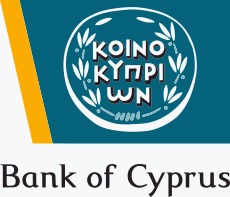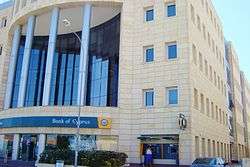Bank of Cyprus
Bank of Cyprus (Greek: Τράπεζα Κύπρου, Turkish: Kıbrıs Bankası) is a Cypriot financial services company established in 1899 and headquartered in Strovolos.
 | |
Native name | Τράπεζα Κύπρου Δημόσια Εταιρεία Λίμιτεδ Kıbrıs Bankası |
|---|---|
| Public Company | |
| Traded as | CSE: BOCY LSE: BOCH |
| ISIN | CY0000100111 |
| Industry | Banking, Financial services |
| Founded | 1899 |
| Headquarters | Strovolos, Nicosia, Cyprus |
Number of locations | |
Area served | Cyprus |
Key people | Takis Arapoglou (Chairman) Panicos Nicolaou (CEO) |
| Products | Retail and business banking, Credit cards, mortgage loans, corporate banking, factoring, insurance, brokerage, private banking, wealth management, Investment management, investment banking. |
| Revenue | |
| Total assets | |
| Total equity | |
Number of employees | |
| Subsidiaries | General Insurance Cyprus EuroLife (Cyprus) |
| Website | bankofcyprus |
Current operations
The Bank of Cyprus currently operates through a total of 108 branches/business offices, of which all operate in Cyprus. The group has representative offices in Romania (€33 million net exposure) Greece, (€309 million exposure) Russia, (€21 million net exposure)[3] Ukraine and China. It is the largest bank in Cyprus by market penetration, with 83% of Cypriots having active Bank of Cyprus accounts, representing a 60% share in total corporate accounts and a 40% share of the overall banking sector.[4]
The shares of the bank are listed on the Cyprus Stock Exchange (CSE). The Bank is the largest listed company on the CSE in terms of market capitalization. Since October 8, 2007 the Bank of Cyprus has been part of the Cyprus 10 Index, which comprises the 10 largest companies in Cyprus. The Bank of Cyprus was also listed on the Athens Exchange since 2000 and had been part of the FTSE/Athex Large Cap index from 9 October 2006 until March 2013. However, in late 2016 it has announced plans to de-list from Athens on 9 January 2017 and list on the London Stock Exchange in January 2017.[5]
History

- 1899 On January 1, 1899, a group of progressive and visionary Cypriots led by Ioannis Economides, a significant figure in financial and social circles, founded the "Nicosia Savings Bank" or "Nicosia Depository" («Ταμιευτήριο η Λευκωσία»). This is the first Cypriot bank; all the other banks in Cyprus are foreign-owned.
- 1912 The "Nicosia Savings Bank" became a public company and changed its name to Bank of Cyprus (BoC), three years after its shareholders had applied to the High Commissioner in 1909.
- 1930 The BoC incorporated as a limited company.
- 1943 The BoC amalgamated with Famagusta Bank and Larnaca Bank (est. 1926).
- 1944 The BoC acquired the Melissa Bank, Paphos, (est. 1924). The Mortgage Bank of Cyprus was established.
- 1945 BoC merged with the Cyprus Savings Bank (Kypriakon Tomieftiron), which had been established in Nicosia in 1908.
- 1953 BoC merged with Paphos Popular Bank (Paphos Laiki Bank) (est. 1924).
- 1955 BoC opened its first branch abroad when it opened in London to serve the Cypriot community there.
- 1960 BoC established a subsidiary, Bank of Cyprus (London) Ltd.: Xeros, Morphou and Zodhia (Nicosia District), Golden Sands, Kato Varosha, Kennedy Avenue, Democratias Avenue, Evagoras Avenue and Oceania (Famagusta Town), Yialousa, Rizokarpaso and Lysi (Famagusta District), and Kyrenia, Karavas and Lapithos branches (Kyrenia District).
- 1982 BoC acquired Standard Chartered Bank's Cypriot operations. (The then Chartered Bank had bought the Ionian Bank's Cypriot operations in 1957.) BoC also opened a representative office in Greece.
- 1986 BoC opened a representative office in Australia.
- 1991 BoC established its first branch in Greece. Kolonaki branch was located at the corner of Vasilissis Sophias Avenue and Sekeri Street, and also boasted a Business Banking Centre and the bank's treasury. In the summer of 2009, this and Mitropoleos Street branches were merged to form the new Syntagma Square branch, which retains branch code 001.
- 1995 BoC opened a representative office in South Africa, and a branch in Heraklion, Crete.
- 1996 BoC established Bank of Cyprus (Channel Islands) in Guernsey, and a representative office in Toronto, Ontario, Canada, located in the heart of Greektown in Toronto to serve mainly the Greek-Cypriot community.
- A subsidiary company, Cyprus Leasing S.A., was established in Greece to deal with leasing activities. It is now the second largest of its kind in Greece. In Cyprus, leasing activities are carried out by a dedicated department of the BoC itself rather than a focused subsidiary.
- 1998 BoC established representative offices in New York and Moscow, and then another in Bucharest, Romania.
- 2000 BoC established a subsidiary in Australia, the country with the world's largest Greek and Cypriot community. The community, which numbers around 600,000 people, is concentrated in Melbourne and Sydney. BOC had long had a presence in the Australian market through its representative offices in Sydney, Melbourne, Adelaide and Brisbane. BoC also opened a representative office in Bucharest.
- BoC bid for Interbank in New York for about $43 million. Interbank was 78% owned by Greek businessman Dimitris Kontominas, and the remaining equity was dispersed among three other shareholders. With four branches in New York, including the Astoria, Queens area where there is a strong Greek presence, the bank catered to the Greek American community. The U.S. Federal Reserve withheld its approval and bid expired.
- 2004 BoC merged its UK branch with its subsidiary Bank of Cyprus (London) Ltd. The combined business is known as "Bank of Cyprus UK".
- 2005 BoC opened its Pallini branch in eastern Athens, thereby reaching 100 branches in Greece.
- 2007 On 8 October, BoC announced that it had opened a branch in Moscow, making it the first Cypriot bank to have banking operations in Russia. In the same year, the opening of two new branches in Athens (Haidari and Spata) meant that the branches in Greece outnumbered those in Cyprus.
- 2008 BoC purchased 80% of Uniastrum, the 9th largest bank in Russia, for US$576 million. Gagik Zakarian and George Piskov, founders of Uniastrum, will retain a 10% stake each as president and chairman, respectively.[6] Uniastrum Bank had over 220 branches throughout Russia and continued to operate under its own name, which however was linked with that of the Bank of Cyprus Group. Just at that time, funds under Uniastrum management went bankrupt. Investors lost US$100 million.
- 2008 BoC acquired 97% of the share capital of AvtoZAZBank in Ukraine, which operated through 26 branches and 18 seasonal cash offices located in Ukraine's four main regions. The bank traded under the Bank of Cyprus name.
- 2010 The Bank of Cyprus decided to establish a banking unit in the Dubai International Financial Centre (DIFC), in the Emirate of Dubai, in the United Arab Emirates. It also established a representative office in India. In Cyprus, Ayios Lazaros branch in Larnaca closed, due to the forthcoming demolition of the building housing it. Despite the harsh economic downturn in Greece, the network there continues to grow, with the opening of 20 branches throughout Greece, with 10 those to be located in Greater Athens, five in Salonica, and five in other areas. Russian oligarch Dmitriy Rybolovlev (through Odella Resources fund) acquired 9.7% of the bank.[7]
- 2011 Bank of Cyprus sold Bank of Cyprus Australia to Bendigo and Adelaide Bank. The former Bank of Cyprus Australia is now known as Delphi Bank.
- 2012 Bank of Cyprus UK became a subsidiary, regulated by the Financial Services Authority. Under pressure from the Central Bank of Cyprus, CEO Andreas Eliades and Deputy CEO Yiannis Pehlivanides resigned as Bank of Cyprus could not reach by private means the 9% Core Tier 1 capital by 30 June 2012 that the European Banking Authority had required. Eliades's replacement was Yiannis Kypri. Later Chairman Theodoros Aristodemou resigned and was replaced by Andreas Artemi. The bank was also forced to re-consider its strategy of rapid international expansion.
- 2012–2013 Due to the harsh economic downturn in both Cyprus and Greece, the Bank of Cyprus began downsizing its network in Greece by closing branches, with the greater Athens area most affected (closures as at March 2013 were the branches at Omonia Square, Phidippides Street, America Square, Gyzi, Tavros, Petralona, Kessariani, Nea Ionia, Yerakas, Spata, Peania, Drapetsona, Ayios Ierotheos and Keratea). Three branches were closed in Salonica (Nikis Street, Stavros and Ionia), one in Patra (Acrotiriou Street, leaving the Corinth Street and Ayea branches in operation), one in Heraclion, Crete (62 Martyrs Avenue), Asklipiou Street in Trikala, which was merged with the town's other branch at 28 October Street, the Corfu Harbour branch was merged with the Corfu Town branch, Ialyssos branch on the island of Rhodes was absorbed by the Rhodes Town branch, while the towns of Alexandria in northern Greece and Loutraki became devoid of Bank of Cyprus branches altogether. In most cases, the ATMs of the branches were either retained on site or transferred to nearby premises to allow former customers some form of access to their accounts. In addition to downsizing the network, the bank reduced its staff by 300 by way of voluntary redundancy, but aimed to further reduce its number of branches first to 110 from 166, and then closing all of its smaller branches with up to five staff, maintaining only a small number of branches in key locations.
- On 26 March 2013 the Greek branches of the bank, along with those of CPB Bank (the Greek arm of the now defunct Laiki Bank) and Hellenic Bank, were sold to Piraeus Bank. Unlike other banks in the Piraeus Bank Group (e.g. Geniki Bank), which retained for a while its corporate identity, the "Bank of Cyprus" brand was replaced in the ex-Bank of Cyprus branches by the Piraeus Bank corporate identity.
- On 29 March 2013 the loan business (advances) of Cyprus Popular Bank Public Co Ltd (Laiki UK), pursuant to a legal decree put in place by the Cypriot authorities, was transferred to Bank of Cyprus Public Co Ltd (Bank of Cyprus.) Also the Romanian operations apart from Head Office and some loans were taken over by Marfin Romania.
- 2013 The good (Cypriot) parts of Cyprus Popular Bank were merged into the new Bank of Cyprus. On 27 March 2013 the board and CEO were replaced. A Special Administrator was put in place (Dinos Christophides) for 4 months to oversee the merger with the good parts of Cyprus Popular Bank. A new interim board (with Dr Sophocles Michaeilides as Chairman) and interim CEO (Christos Sorotos) were put in place for 3 months, to replace the Special Administrator to lead the back to a new Annual General Meeting on 10 September 2013 and to oversee the "bail in" of depositors and to restructure and downsize the new bank. Staff salaries were cut up to 30% and a voluntary retirement scheme was agreed with the bank workers' union. The branch network in Cyprus was also rationalised, as were the head office functions of the two merged banks. A new CEO John Hourican took the helm. with Dr Christis Hasapis as Chairman.
- 2014 The bank sold off non-core assets and has thus sold its stake in the Romanian Banca Transilvania and the Ukrainian bank was also sold. After a 1 billion Euro increase in capital led by CEO John Hourican, a new board and shareholders took the helm in November 2014 led by Josef Ackermann and Wilbur Ross.[8] Ross represented funds that controlled about 19% of the bank, including Renova Group's affiliate Lamesa Investments Ltd 9.2% stake in 2018 (5.46% in 2014) and TD Asset Management with 5.23% in 2014.[9][10]
- 2015 On the 26 January 2015 The bank authorised Bank of Cyprus UK to administer debt on their behalf for all ex Laiki UK (Cyprus Popular Bank Public Co Ltd) customers. The Russian subsidiary Uniastrum Bank was sold in July 2015. The last remaining Romanian Branch is being wound down, so the bank will focus only on its two key markets: Cyprus and the United Kingdom.[11]
- 2016 The Bank repaid its Emergency Liquidity Assistance and de-listed from the Athens Exchange.
- 2017 On 19 January the bank was listed on the London Stock Exchange.
- 2018 In July the bank sold its UK Subsidiary for 103 million pounds Sterling to Cynergy Capital Ltd., to focus on its home market. The branches of the bank's former UK subsidiary were rebranded as Cynergy Bank on 3 December 2018.
- 2019 Chairman Josef Ackermann announced his departure before the May Annual General Meeting and was replaced by Greek banker Takis Arapoglou. CEO John Hourican will also step down in September 2019 and is being replaced by Panicos Nicolaou.[12]
Controversy
Bank of Cyprus (Romania) announced in mid-December 2009 that it had purchased 9.7 per cent of TLV's (Banca Transilvania) shares for EUR 58M, and in May 2010 expressed interest in taking over 20 per cent of the bank's stock. DIICOT, the body that investigates organized crime and terrorism, charged the head of Banca Transilvania's administration council, Horia Ciorcila, and the head of Bank of Cyprus (Romania), Georgios Christofourou, with stock market manipulation and money laundering in this transaction.[13] DIICOT also charged a former vice-president of the administration council or Banca Transilvania, Claudiu Silaghi, along with other individuals. Bank of Cyprus (Romania) denied any wrongdoing. The Bucharest Tribunal acquitted Ciorcila and Christofourou on 4 July 2011, as did the Bucharest Court of Appeal on 27 June 2012. On 2 July 2014, the Romanian High Court of Justice rejected the second appeal made by DIICOT, as ungrounded.[14] Consequently, the acquittal decisions issued by the Bucharest Tribunal (2011) and Court of Appeal (2012), have been maintained, confirming the full acquittal of all the defendants. The decision of the Romanian High Court of Justice is final.
Deposit tax and bailout or bailin
A decision was imposed by EU finance ministers to force depositors in Cyprus to take a loss (bail in), in order to help fund an International Monetary Fund and euro zone bailout (bail-in in the case of Bank of Cyprus: with 47.5% of uninsured depositors, above 100,000 Euro, contributing to the bank's recapitalization).
References
- "Group Financial Results for the six months ended 30 June 2016" (PDF). Bank of Cyprus. Retrieved 31 August 2016.
- "Group Financial Results for the six months ended 30 June 2017" (PDF). Bank of Cyprus. Retrieved 15 November 2017.
- "Bank of Cyprus moves into Russia". BBC. 7 June 2007. Archived from the original on 12 June 2007. Retrieved 2007-06-08.
- "Bank of Cyprus has had ten consecutive quarters of growth". The Business Report. 27 September 2017. Retrieved 27 September 2017.
- "Bank Of Cyprus". Archived from the original on 2007-09-30.
- "Cyprus Bank buys 80 per cent of Russia's Uniastrum". The Economic Times. 28 June 2008. Retrieved 17 December 2018.
- "Russian oligarch key shareholder in Bank of Cyprus". Reuters. 23 September 2010. Retrieved 4 March 2017.
- Brinded, Lianna (11 November 2014). "Bank of Cyprus Funded and Controlled by Ex-KGB, Billionaires and Controversial Former Financiers". International Business Times UK. Retrieved 17 December 2018.
- "CYPRUS: BOCY sets AGM for Nov. 20 - CB green light to Wilbur Ross". Financial Mirror. 23 September 2014. Retrieved 17 December 2018.
- Scannell, Kara; Prokupecz, Shimon (9 May 2018). "Exclusive: Mueller's team questions Russian oligarch about payments to Cohen". CNN. Retrieved 13 December 2018.
- 110 Moments in Our History. 2009. Bank of Cyprus.
- https://www.bankofcyprus.com/en-GB/who-we-are/directors-cvs/-2/
- "Banca Transilvania and Bank of Cyprus heads accused of insider trading". Romanian Business Insider. 12 July 2010.
- "Archived copy". Archived from the original on 2014-07-09. Retrieved 2014-07-08.CS1 maint: archived copy as title (link)
External links
- Official website
- Bank of Cyprus Cultural Foundation Official Website
- Bank of Cyprus Oncology Center Official Website

